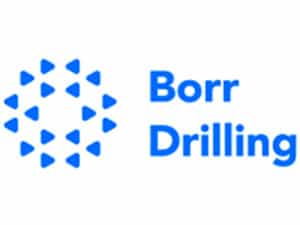
MAN adds LPG burning engine to two-stroke dual-fuel line-up
Written by Nick Blenkey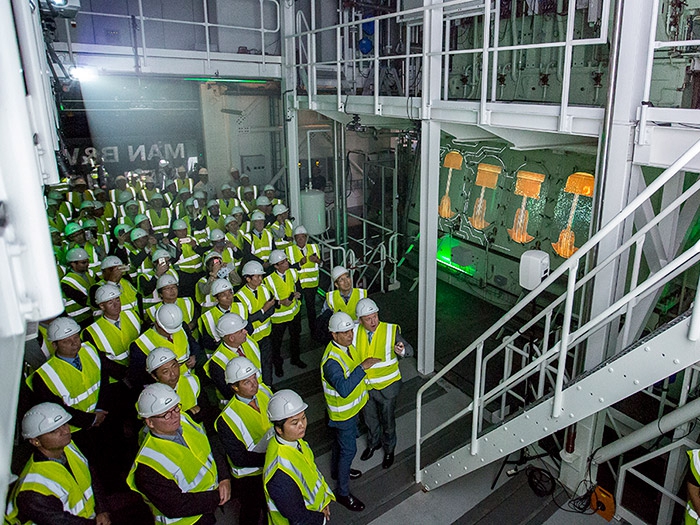
Invited guests and international customers at MAN Energy Solutions' Copenhagen Research Center watching the new MAN B&W ME-LGIP engine in operation, moving seamlessly between diesel-fuel and LPG combustion
SEPTEMBER 3, 2018 — At a ceremony at its PrimeServ facility in Copenhagen, Denmark, before a group of shipowners, shipbuilders, designers, and the international media, MAN Energy Solutions unveiled its latest two-stroke engine, the dual-fuel MAN B&W ME-LGIP engine designed to burn Liquefied Petroleum Gas (LPG).
Attendees to the event witnessed the seamless switchover from diesel to LPG on the ME-LGIP engine on the test bed.
MAN Energy Solutions says the MAN B&W ME-LGIP is the only liquid gas injection dual-fuel engine on the market. It will allow ship operators to switch from Heavy Fuel Oil (HFO), Marine Gas Oil (MGO) and LPG fuels with no loss of performance. Burning LPG could offer owners another choice to comply with IMO’s 0.5% global sulfur cap on marine fuels starting January 1, 2020. LPG contains zero sulfur and is readily available globally.
MAN Energy Solutions also reports that the ME-LGIP engine has experienced an up to 18% reduction in CO2 and about 90% reduction in particulate matter when running on LPG, compared with HFO.
“The ME-LGIP builds on the success we have had with our ME-GI and ME-LGI dual-fuel engines, which have won over 250 orders since their at the ceremony held in Copenhagen,” says Thomas Knudsen, Head of MAN Energy Solutions’ Two-Stroke Engine business unit. “Employing essentially the same proven technology, we can now add LPG to the expanding list of non-HFO and alternative fuels that our two-stroke technology can exploit.”
This past March, MAN Energy Solutions won its first order for the new engine for two VLGCs (Very Large Gas Carriers) being built for Belgium’s EXMAR at Hanjin Heavy Industries’ facility in Subic Bay, the Philippines. The 80,000 m3 newbuildings will each be powered by an individual MAN B&W 6G60ME-LGIP Mk9.5 engine.
EXMAR chose LPG as a fuel option for its VLGCs to comply with the new IMO sulfur-emission legislation due to enter force in 2020. Delivery of the first engine to Hanjin’s Subic Bay shipyard is scheduled for December 5, 2019, followed by the engine for the second vessel, one month later. The two carriers will be chartered by Statoil (see earlier story).
As we reported earlier, BW LPG has ordered ME-LGIP engines to be retrofit on four of its VLGCs (see story). The contracts include options for further future retrofits and will see four MAN B&W 6G60ME-C9.2 HFO-burning engines retrofitted to 6G60ME-C9.5-LGIP LPG-fueled dual-fuel engines. BW LPG expects the first retrofitting to take place in conjunction with scheduled drydockings, starting 2020.
“The arrival of this order, even before the official launch of the ME-LGIP engine itself, is a sign of how timely the technology is,” says Wayne Jones, Chief Sales Officer and member of the Executive Board, MAN Energy Solutions. “We expected a strong demand for the engine from very large gas carriers and it has proven to be so. When you add in MAN Energy Solutions’ entire portfolio of dual-fuel engines, we have now confirmed almost 400 projects, all running on clean fuels such as LNG and LPG. This stands as testament to our leadership within this critical market segment.”
Pontus Berg, BW LPG’s Senior Vice President of Technical and Operations, says, “The signing of the contracts is a culmination of years of close cooperation and partnership between two companies invested in a cleaner future. BW LPG is proud to have worked alongside MAN Energy Solutions on this project, developing the world’s first LPG-propelled dual-fuel engine that will help reduce the environmental footprint of the maritime industry by using fuel that has a greener emissions profile, including an inherent compliance with all current and future sulphur-oxide emissions regulations.”
“Interest in using LPG as a fuel, within and outside of the LPG carrier segment, is growing due to its sulfur-free character, widespread availability and ease of bunkering,” says Bjarne Foldager, Vice President Sales & Promotion – Two-Stroke business unit. “In gas mode, the ME-LGIP engine operates on just 3% pilot oil and down to 10% load. Ultimately, we expect the engine to operate without the need for pilot oil.”
 MAN Energy Solutions expects a strong demand for the ME-LGIP engine from VLGC operators, as well as coastal vessel owners.
MAN Energy Solutions expects a strong demand for the ME-LGIP engine from VLGC operators, as well as coastal vessel owners.
Design of the ME-LGIP cylinder cover with LPG injection valve and gas block
Foldager says, ”The ME-LGIP can also burn liquid volatile organic compounds, a deliberate move on our part since the IMO will inevitably turn its focus towards the reduction of volatile organic compounds in the future. Accordingly, we view the ME-LGIP as also ideally suited to the propulsion of shuttle tankers and very large crude carriers.”
 The Diesel principle provides the ME-LGIP engine with high operational stability and efficiency, including during load changes and fuel change-over, while defining properties such as a stable change-over from one fuel type to another with no fuel-penalties are maintained. The negligible gas slip of the ME-LGIP engine makes it the most environmentally friendly, two-stroke technology available.
The Diesel principle provides the ME-LGIP engine with high operational stability and efficiency, including during load changes and fuel change-over, while defining properties such as a stable change-over from one fuel type to another with no fuel-penalties are maintained. The negligible gas slip of the ME-LGIP engine makes it the most environmentally friendly, two-stroke technology available.
At left, Thomas Knudsen, Head of MAN Energy Solutions’ Two-Stroke business unit, at the presentation of the new MAN B&W ME-LGIP engine
MAN Energy Solutions says that the ME-LGIP engine has demonstrated an up to 18% reduction in CO2 and circa 90% reduction in particulate matter emissions when running on LPG, compared with HFO.
ME-LGIP TECHNOLOGY
The primary characteristics of ME-LGIP engines include:
- a low-pressure supply system
- a fuel-injection system similar to that most recently developed for MAN Energy Solutions’ conventional MDO/HFO engines – the FBIV (Fuel Booster Injection Valve)
- an injection pressure of 500-600 bar
- the ability to handle low-sulfur/low-flashpoint fuel types: methanol, ethanol, LPG, and dimethyl ether (DME).
MAN B&W ME-LGIP engines are designed to be dual-fueled with diesel fuels and LPG as equal alternatives for operation.The ME-LGIP engine is flexible with regard to LPG composition and finds even LPG qualities containing significant amounts of ethane acceptable.
The ME-LGI (-Liquid Gas Injection) concept can be applied to all MAN Energy Solutions low-speed engines from 50-bore and up, either ordered as an original unit or through retrofitting.
The ME-LGI came about due to interest from the shipping world in operating on alternatives to HFO. Methanol and LPG carriers have already operated at sea for many years and many more LPG tankers are currently being built as the global LPG infrastructure grows. With a viable, convenient and comparatively cheap fuel already onboard, it makes sense to use a fraction of the cargo to power the vessel with an important, side-benefit being its positive, environmental performance.
Research engine at Research Center Copenhagen equipped for LPG operation


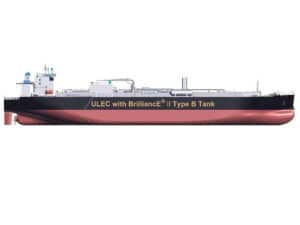
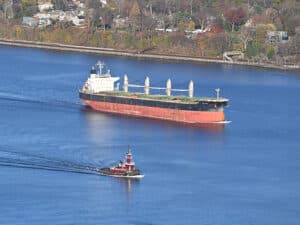

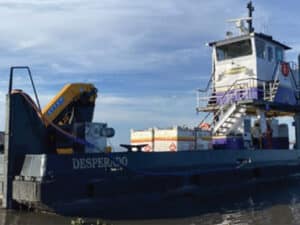
Leave a Reply
You must be logged in to post a comment.